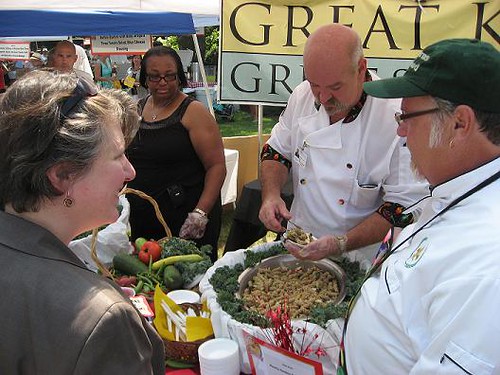Last week I joined Governor O’Malley and Maryland Secretary of Agriculture Buddy Hance for a cook-out at the Governor’s House in Annapolis, Maryland. What a blast! Along with 300 other guests, I sampled wonderful local foods prepared by 19 farmer-chef teams who were the winners in a state-wide recipe contest that showcased their creativity and locally grown and raised foods. It was great to visit with the winning farmers and dozens of others who were on hand to support local and regional agriculture.

I know that Governor O’Malley is a strong supporter of Maryland’s farmers and ranchers. But it was downright inspiring to listen to him as he took the stage to issue a challenge: during this week, buy local challenge week (July 17-July 25), he asked that every Maryland citizen eat at least one locally grown food item each day. Having stopped earlier at Councell Farms roadside stand in Cordova, Maryland, I am well on my way to meeting his challenge. And with over 100 farmers markets in Maryland and an increasing number of retailers selling local produce, it is difficult during sweet corn and tomato season to miss all the opportunities to buy local.
The benefits for consumers (like me) are obvious – delicious and farm fresh food that supports small businesses in my community. But do local markets really make a difference for farmers? With the current drought and unstable dairy prices, I know that Maryland farmers are finding it difficult to make ends meet. Secretary Vilsack and I are concerned about the “disappearing middle” in American agriculture – those farmers and ranchers who find themselves squeezed between low prices for their products and high operating costs. Over the past decade Maryland, like many other states, has been losing many of these mid-sized family farms. According to the latest Census of Agriculture, between 2002 and 2007 alone, 155 Maryland farmers with gross sales between $100,000 and $500,000 disappeared. While some of these farmers may have moved into higher gross sales categories, my best guess is that many just went out of business.
Local and direct markets are one way to help existing farmers hold on and new ones flourish. By being closer to the consumer farmers are able to capture more value for their products.
Making sure consumers have an opportunity to know their farmer is also about appreciating all the things other than delicious food that farmers do for us. Discussion at the Governor’s House focused on the importance of farms to rural economic health. For instance, farms support seed and feed businesses, equipment repair, and food processing. Sustainably managed farm and ranchland is also critical to protecting our water supplies, and in Maryland farmland preservation is a key part of the overall strategy to improve the Bay. Farm kids also populate rural schools and are at the center of maintaining and revitalizing our rural communities.
Perhaps this is why Maryland, like many states, has a program that promotes locally grown and raised foods. I encourage my fellow Terrapins to send me an email and let me know how you are meeting the Governor’s challenge. Now go enjoy that sweet corn!
